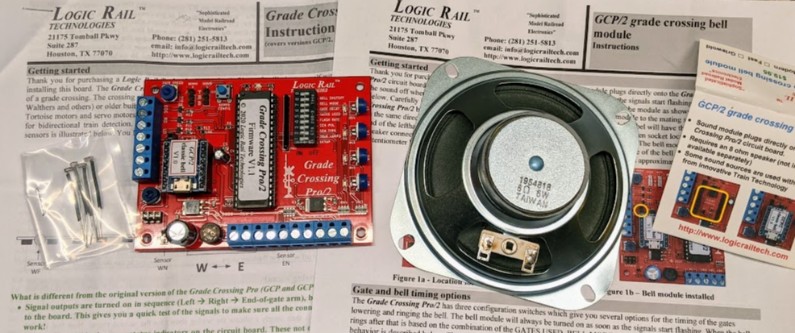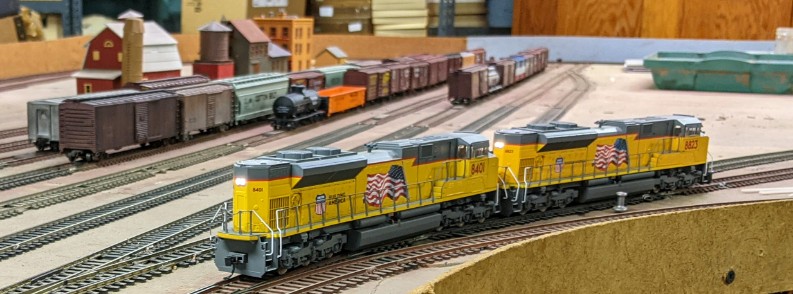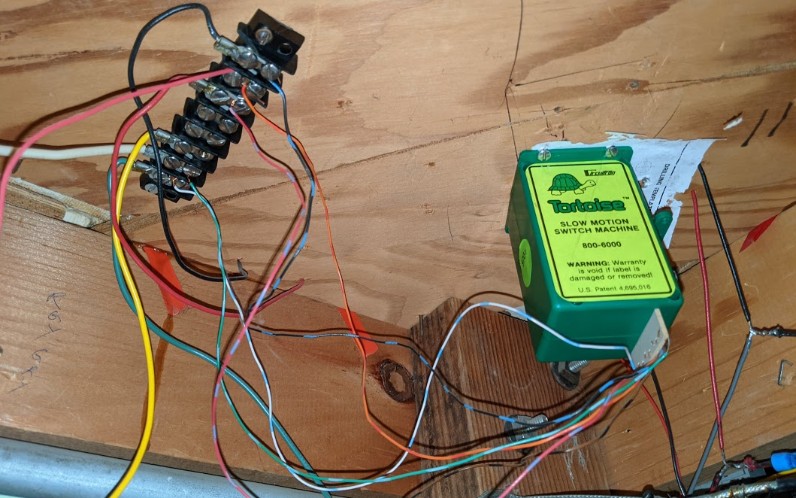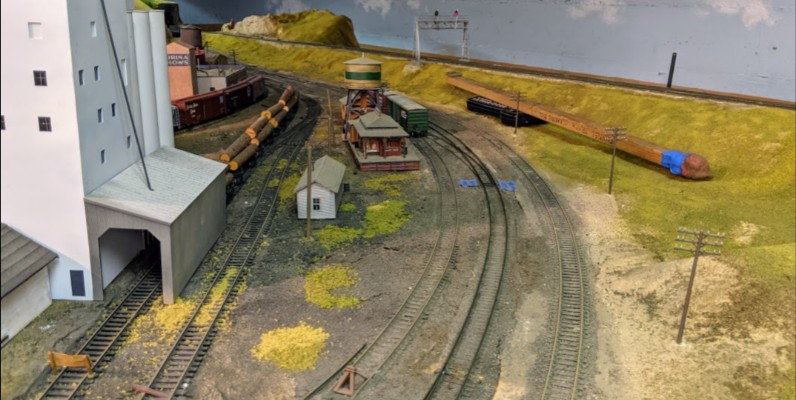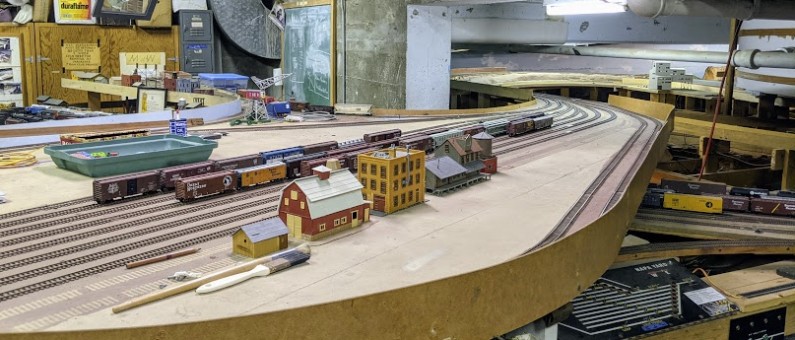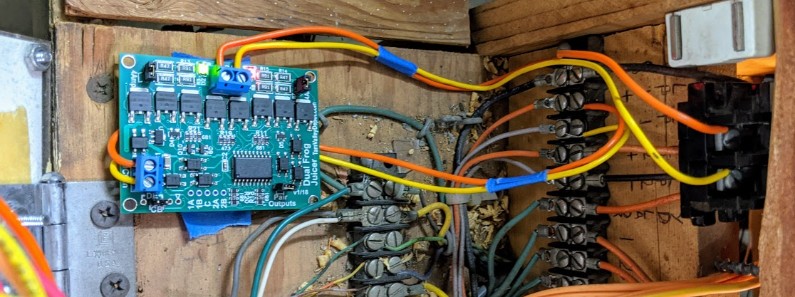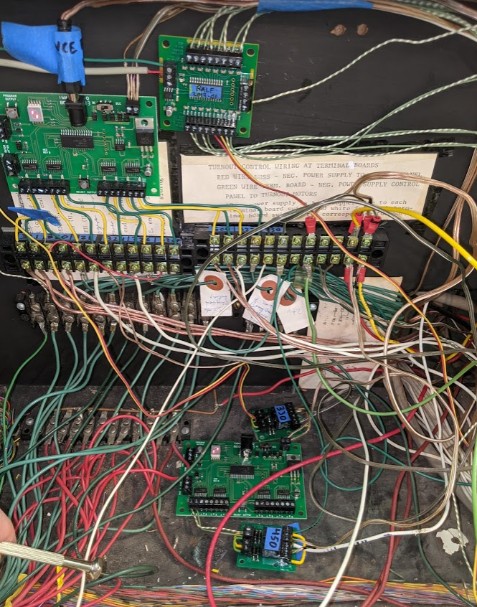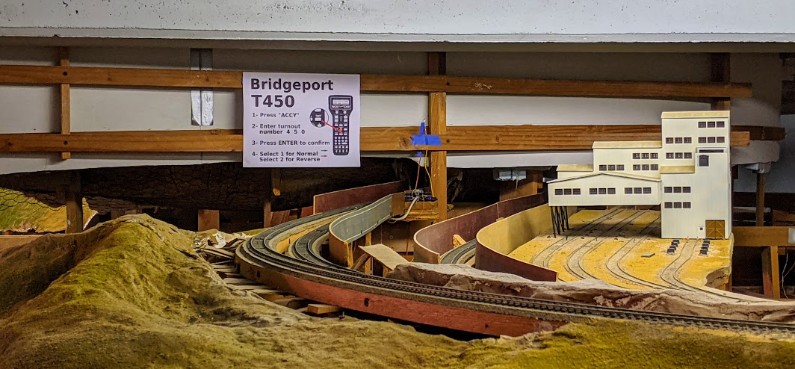The Randall Museum in San Francisco hosts a large HO-scale model railroad. Created by the Golden Gate Model Railroad Club starting in 1961, the layout was donated to the Museum in 2015. Since then I have started automatizing trains running on the layout. I am also the model railroad maintainer. This blog describes various updates on the Randall Museum Model Railroad and I maintain a separate tech blog for all my electronics & software not directly related to Randall.
2020-12-26 - Grade Crossing Pro/2
Category RandallToday on the bench we have a Logic Rail Technologies Grade Crossing Pro/2:
That is going to replace the module that I had previously installed on the layout back in 2015.
Experiment on the bench first, to check everything out:
This is a newer version of the previous Grade Crossing Pro. For comparison, here’s a picture I took back in March 2015 of the brand new one I had installed back then (that’s the module that was unceremoniously removed):
Click here to continue reading...
I recently installed an auto-reverser on one of the two balloon tracks at Bridgeport, as indicated in the previous Bridgeport post. In between I ordered a second one and today I was going to install it.
Two engines led by Walthers Mainline UP 8823 enter the outer balloon track at Bridgeport.
For the auto-reversers, I settled on using the Tam Valley Depot Frog Juicer Auto-reverser; I really like them, they work very nicely.
Unfortunately when the order arrived, I had a little surprise:
Click here to continue reading...
How are Tortoise wired on the layout? A lot of the existing mainline turnouts use a terminal block. This makes it easier to prepare the turnout machine at a bench, and then install it in place without soldering. So let’s replicate this. What is the current wiring pattern?
Some examples:
Tortoise at Mainline T110:
Terminal block = 8 positions (1 == right most).
- Terminal 1 / Green Turnout Control ⇒ Tortoise 8.
- Terminal 2 / White Turnout Control ⇒ Tortoise 1.
- Terminal 3 / Yellow = not connected.
- Terminal 4 / empty.
- Terminal 5 / empty.
- Terminal 6 / Red = DCC bus red or from rail A ⇒ Tortoise 3.
- Terminal 7 / Orange = to frog ⇐ Tortoise 4.
- Terminal 8 / Black = DCC bus black or rail B ⇒ Tortoise 2.
To reverse the switch, it’s possible to invert the green/white either on the bus side or the tortoise side. An 8-position terminal block makes sense to be able to use both switch contacts. In practice, I rarely see that being used.
On the Fulgurex at T450 Bridgeport, the conventions are different.
Click here to continue reading...
The last couple visits at the museum were to deal with Lodi. The original premise was extremely simple as elaborated in the previous post about Lodi: provide access to the block B905 leading from Lodi to Fairfield for switching purposes. Jim indicated he tried to use it only to find it had no power. Since this block is powered off Fairfield, which is currently powered off, the trivial fix was to cut the block in two by creating a gap and then power it from the Lodi side.
Lodi on the left, mainline (the dark rails in the middle), and the Fairfield B905 block on the right.
That did not go smoothly. In fact so far it has gone absolutely nowhere except to create more work for what was supposed to be a trivial thing. Oh well. C’est la vie.
Click here to continue reading...
Bridgeport after some more cleaning and adding a few structures we had laying around:
Today I cleaned the inner balloon track of Bridgeport using our cleaning engine 1201:
As indicated yesterday, the strategy is:
- Manual scrub the track with the Woodland Scenics Track Cleaning tool.
- Run 1201 pushing a roller and pulling a pad car.
- One drop of ATF on the roller pad does help a lot.
- The ATF is combined with manual scrubbing and then running 1201 back and forth several times -- rinse and repeat till the engine goes on smoothly.
What I found in the past is that using too much ATF or Wahl oil just makes the track slippery and attracts more dust in the long run. However one drop of ATF spread out by the roller car creates a smooth film which is visible at first. Then with the scrubber, it does help clean the track till it’s shiny enough and we don’t notice any ATF on it.
I also installed the auto-reverser on the outer “Loop 1” balloon track:
I’m using a Tam Valley Frog Juicer Auto-reverser; I really like them, they work very nicely.
Click here to continue reading...
I guess a better title would be “Digitrax DS64 and Fulgurex do not match”. Well, sort of.
From http://www.clag.org.uk/fulgurex.html:
“Fulgurex motors, as best as I can find, draw around 200 mA when in motion.”
And Digitrax has a technote for the DS64 essentially saying to not even try:
“the Fulgurex motor draws too much current for the DS64”
Although the Digitrax technote indicates the Fulgurex could use “up to 400 mA”, which seems a bit excessive… or is it? I did notice on the Napa ones that I do have a severe voltage drop when driving two (!) Fulgurex at the same time (it’s a crossover). IIRC it was in the 5-6 V range instead of the expected 10-12 V. That means we’re taxing that little DS64 yet the Napa Fulgurex(es) still manage to work, albeit a bit weakly.
That did not work with the Bridgeport Fulgurex though. Voltage was dropping at 3-4 V, which was not enough. Likely that one is using a bit more current.
Anyhow, the Digitrax DS64 I installed last week is out, and in goes a new NCE Switch-8 with an NCE Relay Board to control that Fulgurex, and now everything works as a charm:
The panel is still a mess though, and this is wired as such:
Click here to continue reading...
We now have DCC control for the Bridgeport turnout, with some caveat:
For this I used a Digitrax DS64 to control the Fulgurex slow-motion motor.
As I said… “with some caveats”:
Click here to continue reading...
2020-10-13 - Lodi & Fairfield
Category RandallHere’s something nice: Jim is having a good time operating on the layout at Randall. You can read the details in his Train Orders post: SP Operations Today On Randall Museum Model Railroad.
I did spend some time cleanup the Napa yard, and making the Napa-mainline interchange more functional, and this is paying off.
Jim has also started using Lodi for switching. I’m really glad to learn that. First it’s a really neat part of the layout that is quite underused. Second I appreciate the use of it for switching operations, and not just running in a loop. Having operational variety is the whole point of a layout like the one designed at Randall.
That came with a request, which I fully support:
Click here to continue reading...
2020-09-27 - State of Projects
Category RandallTime for a little recap on pending projects, and a vague attempt at prioritizing them. This is an update for my post [2020-02-29 - Pending Work on the Layout]. Not going to make a fancy table this time, yet the same categorization as before is relevant, namely impact on layout running, impact on public viewing, and time/complexity.
The slight difference is that right now I am not prioritizing immediate public viewing since the museum is still closed till further notice. However we have weekly running to keep the track clean, so even if automation is off for a little bit, the layout must be running.
Currently, these are the projects I expect to be working on, in this order:
- ESP32-CAM for Grade Crossing.
- Impact: Immediate for running / public.
- Complexity: High. Lots of uncertainties. Time consuming R&D.
- Really needs an initial prototype. It’s a two-phase project: validate the concept, then implement the real one. Don’t expect something right away -- thus avoid advertising it before it is known to be functional.
- Power block for Stockton station.
- Impact: None for running, none visible for public automation.
- Complexity: Low. Just time consuming pulling wires.
- Will open the door for adding block sensors in the Stockton yard and providing more automation.
- This may help with the stopped automation train being affected by DCC commands in Stockton Yard.
- Finish 3rd turnout indicator in the Napa approach.
- Impact: Medium-useful for running
- Complexity: Low.
- Complete Conductor 2 software.
- Impact: None for running, none visible for public automation.
- Complexity: High. Long term.
- Will open the door for more automation down the road. I have a partial early prototype, which I never fully finished fletching out. There are still some open questions as to whether the new design can do what I need, then it needs to be fully implemented.
As usual, it needs to be said this list is dynamic. I will adjust my priorities as I see fit. Any maintenance repairs on the layout take priority.
There are other pending projects, which I honestly do not see working myself on in a reasonable time frame:
Click here to continue reading...
Jim is getting a new crossing signal for the Fairfield station:
This is to replace the previous version I did:
A bit of history on what happened to the signal that can be seen in the video, and a personal rant:
The old signal and its controller were removed by Marvin Chow when the GGRMC closed in 2015 -- from what I understand, he had donated such a signal a decade or so ago before leaving the club; the signal had failed and I had replaced it, and then he removed the one I had installed without asking anyone, claiming it was his and proceeded to donate it again to the Carquinez MRR. Rather pathetic to even claim to donate something and then take it back with the typical sleazy excuse of “well I didn’t really donate it, it was a loan”... sure. Whatever.
Anyhow, Jim got a new crossing signal, and we need to power it. Last time I connected it to a LogicRail Tech Grade Crossing Pro and its associated Bell sound module. These are the elements that were taken out unceremoniously. I could reuse the same -- they work well, within their limitations, or I could try to make an Arduino version and experiment in the process.
Click here to continue reading...
